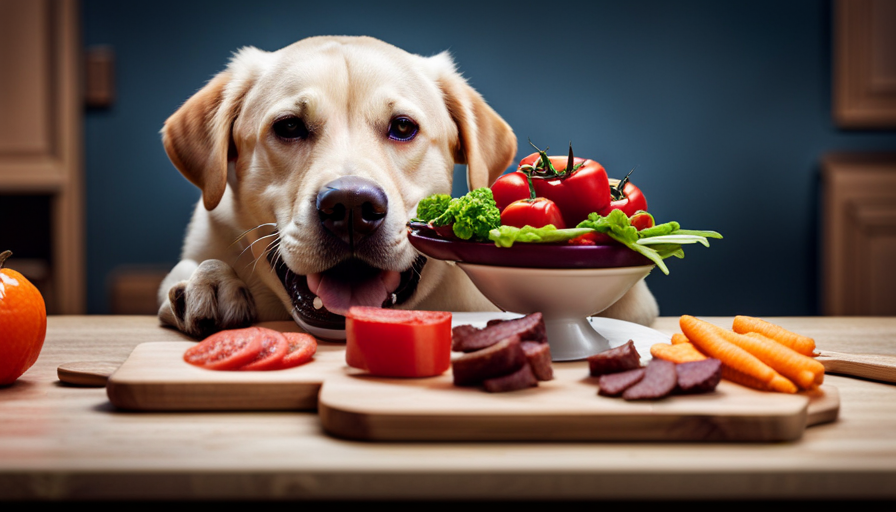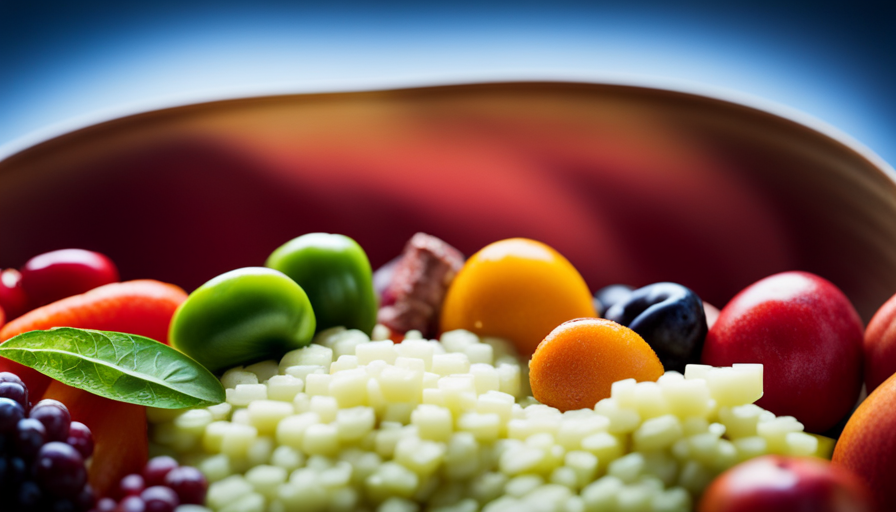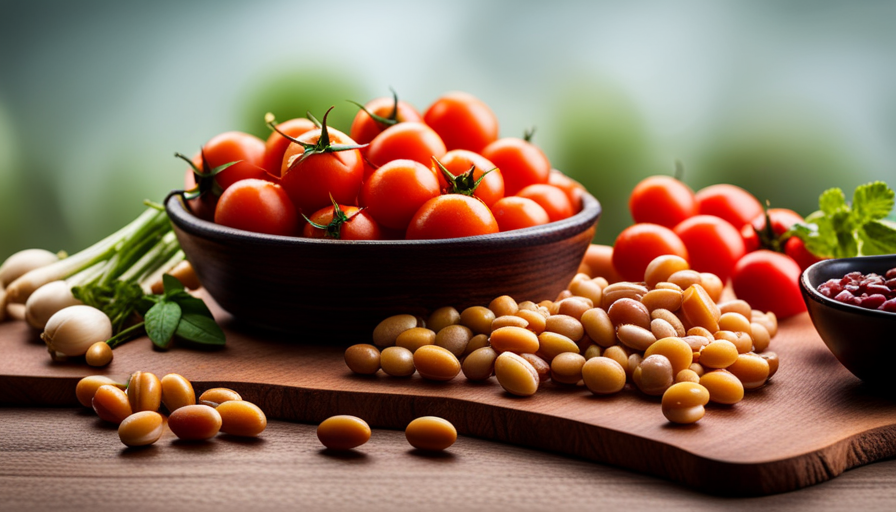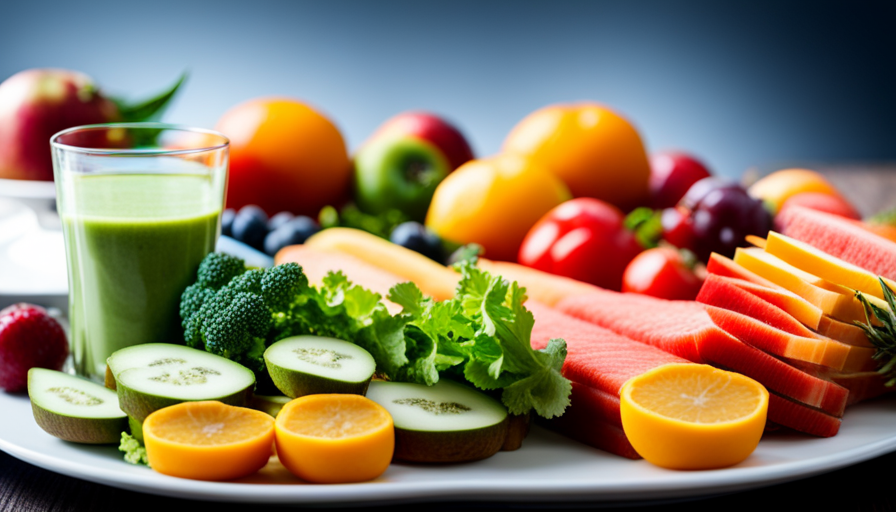Picture yourself as a Labrador, dashing through an expansive meadow with the wind ruffling your fur and the sun beaming overhead. Your enthusiasm knows no bounds as you sprint after a ball, your muscles brimming with vitality and strength.
Now, imagine if every meal you ate could fuel that same vitality and well-being. That’s the power of a whole-food raw diet for Labradors.
In this article, I will guide you through the process of feeding your beloved Labrador a raw diet that is based on natural, unprocessed ingredients. From understanding the benefits of a raw diet to finding quality raw food sources, I’ll provide you with all the information you need to make the best choices for your furry friend’s health.
So, let’s dive in and unlock the incredible potential of a raw diet for your Labrador!
Key Takeaways
- Consulting with a veterinarian is crucial for guidance on a balanced raw diet plan tailored to Labrador’s specific needs.
- Transitioning to a raw diet should be done gradually to allow the digestive system to adjust.
- Balancing nutritional needs includes including muscle meat, bones, organs, fruits, and vegetables in their diet.
- Safe handling and hygiene practices are essential when preparing raw food for Labradors.
Understand the Benefits of a Raw Diet for Labradors
Feeding your Labrador a whole-food raw diet can provide them with numerous benefits that contribute to their overall health and well-being. The transitioning process to a raw diet may take some time and effort, but the potential benefits make it worth considering.
One of the main advantages of a raw diet is that it more closely resembles what dogs would eat in the wild. This means that labradors can receive the necessary nutrients in a more natural and easily digestible form. Additionally, a raw diet can help improve a dog’s coat health, reduce allergies, and promote better dental health.
However, it’s important to note that there are potential drawbacks to a raw diet as well. Raw diets can be more expensive and time-consuming to prepare compared to commercial dog foods. There’s also a risk of bacterial contamination if proper food handling and storage protocols aren’t followed.
To ensure the best results for your Labrador, it’s crucial to consult with your veterinarian. They can provide guidance on the specific nutritional needs of your dog, help you create a balanced raw diet plan, and address any concerns or questions you may have. By working closely with your veterinarian, you can ensure that your Labrador receives the optimal nutrition from a whole-food raw diet.
Consult with Your Veterinarian
Consult with your vet to get their professional guidance and ensure your furry friend’s health is in safe hands. Your veterinarian plays a crucial role in helping you navigate the world of alternative diets for your Labrador. Here are three reasons why consulting with your vet is important:
-
Expertise: Veterinarians have extensive knowledge and experience in animal nutrition. They can provide you with evidence-based information about the benefits and potential risks of a raw diet for Labradors. They can also guide you on how to create a balanced and nutritious raw meal plan tailored to your dog’s specific needs.
-
Health Assessment: Your vet will assess your Labrador’s overall health and determine if a raw diet is suitable. They will consider factors such as age, activity level, and any underlying health conditions. This assessment ensures that the raw diet will meet your dog’s nutritional requirements and support their well-being.
-
Monitoring and Support: Transitioning your Labrador to a raw diet requires careful monitoring and adjustments. Your vet can help you monitor your dog’s weight, body condition, and overall health throughout the transition. They can also provide guidance and support if any issues or concerns arise along the way.
By consulting with your vet, you can ensure that your Labrador’s transition to a raw diet is safe and successful.
In the next section, we will discuss how to smoothly transition your Labrador to a raw diet without causing any digestive issues.
Transitioning Your Labrador to a Raw Diet
When transitioning my Labrador to a raw diet, I started slowly with small portions to allow his digestive system to adjust. I gradually introduced a variety of meats and bones to provide a balanced diet and prevent any nutrient deficiencies.
Throughout the process, I closely monitored my Labrador’s response and made adjustments as needed to ensure he was thriving on the new diet.
Start Slowly with Small Portions
Ease your Labrador into a whole-food raw diet by starting with small portions, allowing them to savor the goodness and gradually embracing this nourishing change. Transitioning your dog to a raw diet can be a gradual process to ensure a smooth adjustment. Starting with small portions helps their digestive system adapt to the new diet, reducing the chances of stomach upset or discomfort. It also gives you an opportunity to observe any potential challenges that may arise during the transition process.
To help evoke an emotional response, imagine the joy on your Labrador’s face as they enjoy their first taste of raw food. Picture the wagging tail and the excitement in their eyes. This transition period is a crucial time for your dog’s well-being, so it’s important to take it slow and be patient.
In the next section, we will discuss how to gradually introduce a variety of meats and bones to ensure a balanced and nutritious diet for your Labrador.
Gradually Introduce a Variety of Meats and Bones
Imagine the thrill of watching your Labrador discover a world of delicious meats and bones, gradually introducing a variety that’ll provide them with a balanced and nutritious diet. When starting your Labrador on a whole-food raw diet, it’s important to introduce new meats and bones slowly. This allows their digestive system to adjust and helps prevent any potential upset stomachs. Here are five tips to help you successfully introduce a variety of meats and bones:
- Start with one type of protein, such as chicken or beef, and gradually add more options over time.
- Offer different cuts of meat, like ground, chunks, or whole pieces, to provide variety in texture.
- Experiment with different types of bones, such as chicken wings or beef ribs, to promote dental health and exercise their jaw muscles.
- Include organ meats like liver or heart, which’re rich in vitamins and minerals.
- Rotate protein sources to ensure a well-rounded diet.
By introducing a variety of meats and bones slowly, you can monitor your Labrador’s response and adjust their diet as needed, ensuring their health and happiness.
Monitor Your Labrador’s Response and Adjust as Needed
To ensure optimal health and happiness for your Labrador, closely monitor their response to the gradual introduction of various meats and bones, making necessary adjustments along the way.
Start by introducing one type of meat or bone at a time, carefully observing any changes in their digestion, energy levels, coat condition, and overall well-being. If you notice any negative reactions such as excessive gas, diarrhea, or skin irritations, it may indicate a food allergy or sensitivity. In such cases, eliminate the offending ingredient and consult with a veterinarian for further guidance.
Additionally, it’s essential to adjust portion sizes based on your Labrador’s age, weight, activity level, and overall health. Regularly assess their body condition and weight to ensure they are receiving the appropriate amount of food.
By closely monitoring your Labrador’s response and adjusting portion sizes as needed, you can provide them with a balanced and nourishing raw diet.
Transitioning into the subsequent section about ‘balancing nutritional needs,’ it’s important to consider the specific nutrient requirements for your Labrador’s optimal health.
Balancing Nutritional Needs
When transitioning my Labrador to a raw diet, it’s important to balance their nutritional needs. This can be achieved by including muscle meat, bones, and organs in their meals. Muscle meat provides essential proteins for muscle growth and repair, while bones are a natural source of calcium and other minerals. Organs, such as liver and kidney, are rich in vitamins and minerals.
Additionally, adding fruits and vegetables to their diet can provide fiber for digestion and antioxidants for overall health. It’s also crucial to consider incorporating supplements if necessary to ensure they’re getting all the necessary vitamins and minerals.
Including Muscle Meat, Bones, and Organs
For a truly nourishing diet, make sure to include a variety of muscle meat, bones, and organs when feeding your Labrador a whole-food raw diet. The muscle meat should make up about 70-80% of their diet and should consist of different types such as beef, chicken, and turkey. This variety ensures that your Labrador gets a wide range of essential nutrients.
When sourcing organs, it’s important to include liver, as it’s a rich source of vitamins A and B, iron, and other minerals. You can also include other organs like kidneys, heart, and lungs, which provide additional nutrients.
Including bones is crucial for dental health and to provide calcium and other minerals.
To transition into the subsequent section about adding fruits and vegetables for fiber and antioxidants, it’s important to note that these additions further enhance the overall nutritional value of the diet.
Adding Fruits and Vegetables for Fiber and Antioxidants
Including a variety of fruits and vegetables in my Labrador’s meal plan not only adds fiber and antioxidants but also enhances the overall nutritional value of their diet. Fiber is essential for maintaining a healthy digestive system and preventing constipation. It promotes regular bowel movements and can help prevent gastrointestinal issues in dogs.
Fruits and vegetables also provide a wide range of antioxidants, which are important for reducing inflammation and protecting against chronic diseases. Some great sources of fiber for Labradors include sweet potatoes, pumpkin, and green leafy vegetables like spinach. When it comes to antioxidants, blueberries, cranberries, and carrots are excellent options. These colorful additions not only make the meal more visually appealing but also provide additional health benefits for my Labrador.
Incorporating supplements, if necessary, can further support their nutritional needs and overall well-being.
Now let’s discuss incorporating supplements, if necessary, into my Labrador’s whole-food raw diet.
Incorporating Supplements, if Necessary
Supplementing with vitamins and minerals can be like adding the final brushstrokes to a masterpiece, ensuring that my Labrador’s diet is complete and balanced.
While a whole-food raw diet provides many essential nutrients, there may be cases where supplements are necessary. It’s important to consult with a veterinarian to determine if your Labrador requires any specific supplements based on their individual needs.
Some supplement options that may be beneficial include omega-3 fatty acids for joint health, probiotics for gut health, and glucosamine for joint support. These supplements can help address specific nutritional deficiencies or support overall health.
However, it’s crucial to remember that supplements should not replace a balanced, whole-food raw diet. With the right combination of whole foods and supplements, I can provide my Labrador with a nutritionally complete and wholesome diet.
Moving forward, it’s important to also consider the proper handling and preparation of raw food to ensure the safety of my Labrador’s meals.
Handling and Preparing Raw Food Safely
When handling and preparing raw food for your labrador, remember to follow proper safety measures to ensure the health and well-being of both you and your furry friend.
Safe handling and hygiene practices are essential to prevent the risk of bacterial contamination and foodborne illnesses. Start by washing your hands thoroughly before and after handling raw food. Use separate cutting boards and utensils for raw meat to avoid cross-contamination with other foods. Keep the raw food stored at the appropriate temperature to prevent bacterial growth. It’s also important to thaw frozen raw food in the refrigerator, not on the countertop, to avoid bacterial multiplication.
When preparing the raw food, ensure that all the ingredients are fresh and of high quality. Remove any bones that could pose a choking hazard to your labrador. Cut the food into appropriate sizes, taking into consideration your dog’s age, size, and chewing abilities. Store any leftovers in airtight containers and discard them if they’re not consumed within a safe timeframe.
By following these safe handling and preparation practices, you can minimize the risk of foodborne illnesses and ensure the safety of your labrador.
Moving forward, it’s crucial to monitor your labrador’s health and well-being closely to ensure that the raw diet is meeting their nutritional needs.
Monitoring Your Labrador’s Health and Well-being
Keeping an eye on your Labrador’s health and well-being is essential when introducing them to a new diet. As you transition your Labrador to a whole-food raw diet, it’s important to establish a feeding routine that suits their needs.
Labradors are known for their hearty appetites, so it’s crucial to monitor their portion sizes to prevent overfeeding. Additionally, ensure that your Labrador is getting the right balance of proteins, fats, and carbohydrates for optimal nutrition.
Regular exercise is also key to maintaining your Labrador’s health and well-being. These active dogs require daily physical activity to burn off excess energy and maintain a healthy weight. Regular walks, playtime, and interactive toys can help meet their exercise requirements.
By monitoring your Labrador’s health and incorporating a consistent feeding routine and exercise regimen, you can help them thrive on a whole-food raw diet.
In the next section, we will discuss troubleshooting common issues that may arise during the transition process.
Troubleshooting Common Issues
If you’re experiencing any hiccups during the transition process, here are some common issues you may encounter and how to troubleshoot them.
One common issue when feeding your Labrador a whole-food raw diet is digestive issues. Some dogs may experience loose stools or diarrhea when first switching to raw food. To address this, make sure you’re gradually introducing the new diet and allowing your dog’s digestive system time to adjust. You can also try adding a digestive enzyme supplement to help with the transition.
Another common issue is dealing with picky eaters. Some Labradors may be hesitant to try new foods or may lose interest in their meals. In this case, you can try adding some variety to their diet by including different proteins and vegetables. You can also try hand-feeding your dog or using food puzzles to make mealtime more engaging. Remember, patience is key when troubleshooting these issues. It may take some time for your Labrador to fully adjust to their new diet.
In the next section, we’ll discuss finding quality raw food sources.
Finding Quality Raw Food Sources
Finding top-notch raw food sources is like discovering hidden treasure for your Labrador’s health and well-being. When it comes to feeding your furry friend a whole-food raw diet, it’s essential to find local suppliers that offer high-quality ingredients.
Many cities have specialized pet stores or butcher shops that carry raw food for dogs. These suppliers often provide a variety of options, including different types of meat, bones, and organs, ensuring a balanced diet for your Labrador.
In addition to local suppliers, online raw food delivery services have become increasingly popular. These services allow you to conveniently order raw food for your Labrador and have it delivered straight to your doorstep. They often offer a wide selection of products, making it easy to find exactly what you need to meet your dog’s dietary requirements. It’s important, however, to thoroughly research the company and read reviews to ensure they provide reliable and high-quality raw food.
As you transition into the next section about cost considerations, it’s important to note that while finding top-notch raw food sources is crucial for your Labrador’s health, it’s also important to consider your budget.
Cost Considerations
When it comes to finding quality raw food sources for my Labrador’s diet, I understand the importance of considering cost. While I want to provide the best nutrition for my furry friend, I also need to ensure that it fits within my budget.
Sourcing the most affordable options for a whole-food raw diet can take some time and research, but it’s well worth the effort. Here are some cost considerations to keep in mind:
-
Buying in bulk: Purchasing raw food in larger quantities can often lead to cost savings. Look for suppliers or local farmers who offer bulk discounts.
-
Local sources: Explore local options such as farmers’ markets, butchers, or co-ops. These sources may have lower prices compared to pet stores or online retailers.
-
DIY preparation: Consider making your own raw meals for your Labrador. While it requires more time and effort, it can be more cost-effective in the long run.
-
Seasonal ingredients: Opt for seasonal ingredients when possible, as they tend to be more affordable and readily available.
By considering these cost-saving strategies, I can ensure that my Labrador receives a high-quality, whole-food raw diet without breaking the bank. But what are some frequently asked questions about feeding labradors a raw diet? Let’s find out in the next section.
Frequently Asked Questions about Feeding Labradors a Raw Diet
Wondering about some commonly asked questions regarding feeding your Labrador a raw diet? Let’s dive in and find out! Switching your Labrador to a whole-food raw diet can have numerous benefits. It can improve their digestion, promote a shinier coat, increase energy levels, and even strengthen their immune system. However, it’s essential to consult with your veterinarian before making any dietary changes for your dog.
One frequently asked question is whether a raw diet provides all the necessary nutrients for a Labrador. The answer is yes, as long as the diet is well-balanced and includes a variety of ingredients such as muscle meat, organs, bones, and vegetables.
Another common concern is the safety of feeding raw meat to dogs. While there’s a slight risk of bacterial contamination, proper handling and sourcing of ingredients can minimize this risk.
Many dog owners also wonder if a raw diet is suitable for Labradors with specific health conditions. Again, consulting your veterinarian is crucial, as they can provide tailored advice based on your dog’s individual needs. They can help determine if a raw diet is appropriate and suggest any necessary modifications.
A whole-food raw diet can provide numerous benefits for your Labrador. However, it’s essential to seek guidance from a veterinarian to ensure your dog’s specific dietary requirements are met.
Frequently Asked Questions
Can I feed my Labrador a raw diet if they have specific dietary restrictions or food allergies?
Feeding labradors with food allergies or dietary restrictions can be challenging, but it’s possible to adapt a raw diet for them. Start by identifying the specific allergens and restrictions, and work with a veterinarian or canine nutritionist to create a balanced meal plan. Consider alternative protein sources and include fruits and vegetables that are safe for your dog.
Monitor their health closely and make adjustments as needed. Always consult a professional to ensure your dog’s nutritional needs are met.
How do I ensure that my Labrador is getting all the necessary nutrients from a raw diet?
Ensuring nutrient balance on a raw diet for my Labrador is crucial. To achieve this, I consult with a veterinarian or canine nutritionist. They help me formulate a balanced meal plan that includes a variety of proteins, fruits, vegetables, and supplements if needed.
Transitioning to a raw diet requires a gradual process, introducing raw food slowly while monitoring my dog’s health and digestion. Regular check-ups and blood tests help ensure my Labrador is receiving all the necessary nutrients.
Are there any potential risks or concerns associated with feeding Labradors a raw diet?
Potential health risks and nutritional deficiencies are concerns associated with feeding labradors a raw diet. Raw diets may contain harmful bacteria such as Salmonella or E. coli, which can lead to foodborne illnesses in both dogs and humans.
Additionally, without proper supplementation, a raw diet may lack essential nutrients like calcium, vitamin D, and vitamin E.
It’s crucial to consult with a veterinarian and follow a balanced raw diet plan to minimize these risks and meet your labrador’s nutritional needs.
Can I feed my Labrador a raw diet if they have a sensitive stomach or digestive issues?
If your Labrador has a sensitive stomach or digestive issues, a raw diet may not be the best option. However, there are alternative diets that can be beneficial. Consult with your veterinarian to determine the best course of action. They may recommend a cooked diet or a limited ingredient diet that’s easier to digest.
It’s important to address your dog’s specific needs to ensure their overall health and well-being.
What are some common signs that my Labrador may not be thriving on a raw diet, and how can I address these issues?
When addressing common issues and troubleshooting a raw diet for my Labrador, I need to be aware of signs that they may not be thriving. These can include diarrhea, vomiting, weight loss, or nutrient deficiencies.
To address these issues, I can consult with a veterinarian to ensure my Labrador’s diet is properly balanced and meets their nutritional needs. Adjusting the proportions of meat, bones, and organs, and introducing supplements if necessary, can help resolve these problems and ensure my Labrador’s optimal health.
Can I Feed My Labrador A Whole-Food Raw Diet for an Extended Period of Time?
Yes, you can feed your Labrador a whole-food raw diet for an extended period of time. Many dog owners believe that raw food for German Shepherds, as well as other breeds like Labradors, can provide the necessary nutrients for optimal health. Always consult with a veterinarian before making dietary changes.
Conclusion
In conclusion, transitioning my Labrador to a whole-food raw diet has been a game-changer for his health and well-being.
Through consulting with my veterinarian, I’ve learned about the numerous benefits of this diet, such as improved digestion and a shinier coat.
By carefully balancing his nutritional needs and handling and preparing raw food safely, I’ve been able to ensure that he receives all the necessary nutrients.
Additionally, finding quality raw food sources and considering the cost have been important factors in maintaining this diet.
Overall, this experience has taught me that "you’re what you eat," and providing my Labrador with a raw diet has truly made a world of difference.










